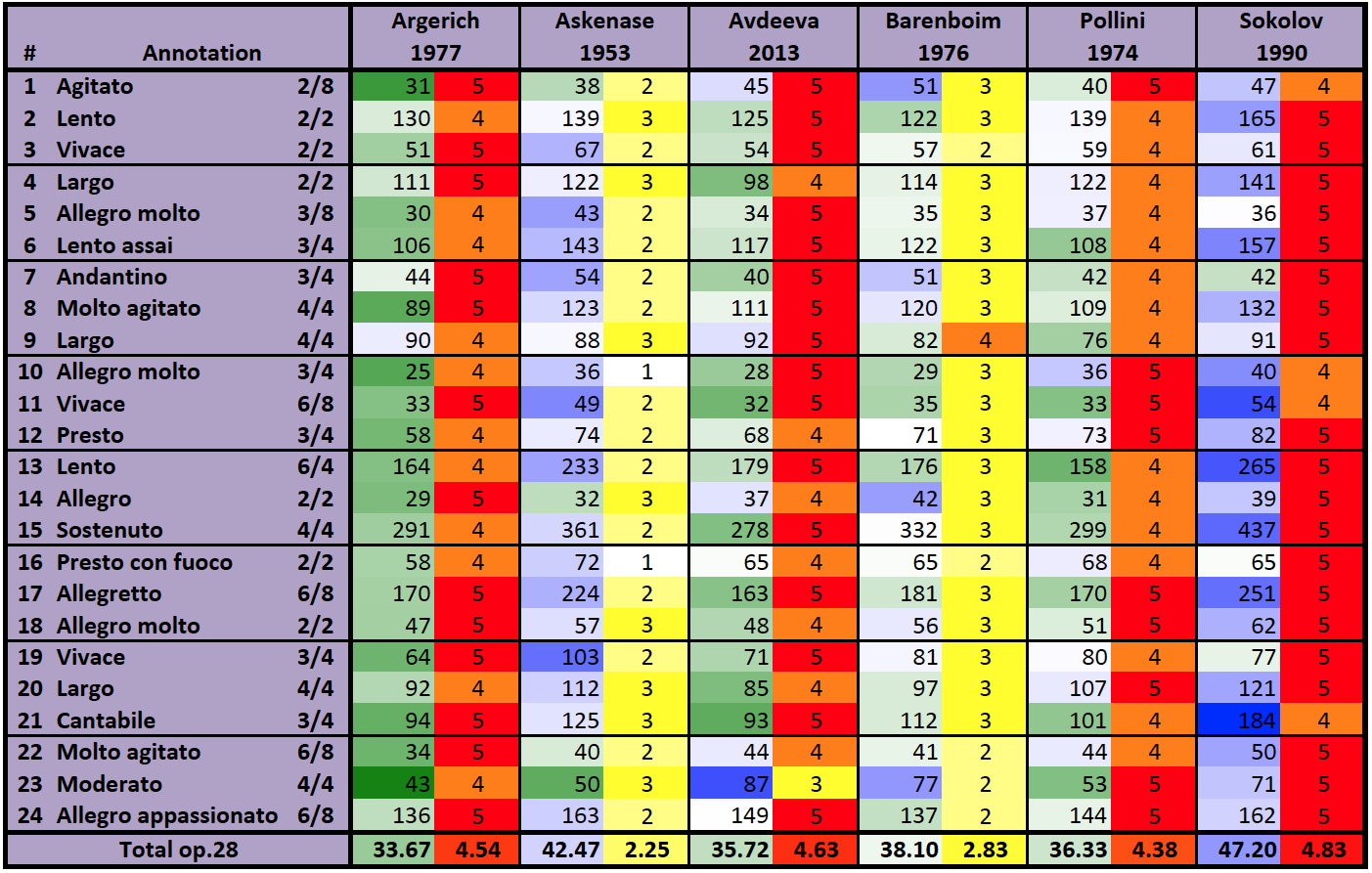Frédéric Chopin
Etudes op.25, Sonata #2, Préludes
Media Review / Listening Diary 2012-11-22
2012-11-22 — Original posting (on Blogger)
2013-08-06 — New standard layout applied
2014-03-26 — Added Yulianna Avdeeva’s interpretation for the Préludes op.28
2014-11-08 — Re-posting as is (WordPress)
2016-07-10 — Brushed up for better readability
Table of Contents
The short comparisons in this blog entry originated from the acquisition of a CD set with Grigory Sokolov playing music by Frédéric Chopin:
Frédéric Chopin (1810 – 1849): 12 Etudes op.25
The CDs
Grigory Sokolov
Chopin: 24 Préludes, op.28; Sonata #2 op.35 (B♭ minor); 12 Etudes op.25
Grigory Sokolov (live recordings)
naïve OP30456 (2 CD, stereo); ℗ 1995 / © 2007

Maurizio Pollini
Chopin: 12 Etudes op.10; 12 Etudes op.25; 24 Préludes op.24; Polonaises opp.26, 40, 44, 53; Polonaise-Fantaisie op.61
DG 431 221-2 (3 CD, stereo); ℗ 1982 – 1976

Vladimir Ashkenazy
Chopin: 12 Etudes op.10; 12 Etudes op.25
Decca 414 127-2 (CD, stereo); ℗ 1975 / ©1984

Comparison Table
I’m not doing a piece-by-piece analysis here. Instead, I created a little table (see below, click for full-size view), listing Chopin’s metronome markings, then, for every artist, the artist’s metronome reading (approximate), my rating (* .. *****), and the duration for every Etude (applause subtracted):
Comments & Findings
General
In my opinion, one should read Chopin’s metronome markings with a grain of salt. The touch and the speed of the piano mechanics at his time probably were closer to a fortepiano than to a modern concert grand (as played by all artists here);
Vladimir Ashkenazy
The recording with Vladimir Ashkenazy is an early CD acquisition, purchased for comparing Chopin’s original Etudes with the Godowsky paraphrases (“Etude studies”), of which I was listening to recordings with Carlo Grante and André Hamelin (whereby I prefer the latter recording almost throughout). I selected Ashkenazy because I had Pollini and others on LP and was looking for something new.
This interpretation (from 1975) is OK, for me a bit conventional, not focusing on brilliance or transparency; in Etude #5, the Vivace part is the fastest of all (clearly faster than Chopin’s annotation), while the Più lento part is played at half the tempo, slower than anyone else (much slower than Chopin’s annotation). Note that on Ashkenazy’s CD, there are two Etudes per track.
Maurizio Pollini
At some point nostalgia started pulling in. I was looking to add my “old friends” (on LP) also to my CD collection — hence the addition of the recording with Maurizio Pollini.
The recording from 1972 is excellent, virtuosic, transparent, clear. In the first Etude I prefer his performance over Sokolov’s. He plays fast, at exactly Chopin’s metronome rating, very accurate, and showing the big phrase;
Grigory Sokolov
Recently, having heard several of his performances (in excerpts, mostly) on YouTube, I could not resist adding the CD set with Grigory Sokolov — and that proved to be an excellent choice!
The Etudes were recorded live, on 1995-06-13 in Saint Petersburg. With the exception of the very first Etude I give him the highest rating everywhere (in Etude #5 I was tempted to extend the scale to 6 points!!). This is simply an excellent performance, not even considering that it’s the only live performance in this comparison!
In Etude #1 I rated Pollini slightly higher: Sokolov seemed maybe a little too focused on small-scale phrasing and articulation (while Pollini focused on flow and the big phrase / evolution). But then, this was the the first piece in a live concert, always a bit of a tricky spot (artists should be allowed to play the first movement twice!!). In general, Sokolov stands out in detailed articulation, “singing” melodies, transparency and clarity: and excellent interpretation, and an absolute must-have, I think!
Yulianna Avdeeva
Finally, I have a track with Yulianna Avdeeva playing Etude #11, recorded live on 2010-05-02, about half a year before she won the 16th Chopin Competition in Warsaw in 2010. It’s excellent, too — but I won’t discuss it any further here, as it is not available on a commercial CD. Also, in that half-year up to the competition, Yulianna Avdeeva’s interpretation evolved a lot (see below for a related discussion). I think it is a bit unfair to compare this early recording to interpretations such as Sokolov’s and Pollini’s. Still, as my numeric rating shows, she has nothing to hide, and her level of playing is not too far from these artists!
Chopin: Sonata No.2 in B♭ minor, op.35
The CDs
Martha Argerich
Chopin: 24 Préludes, op.28; Sonata #2 op.35 (B♭ minor)
DG 463 663-2 (CD, stereo); ℗ 1975/1977

Stefan Askenase
“A Tribute to Chopin” (various works)
Stardust Records / iTunes download (256 Kbps, stereo); ℗ 2007
(no booklet)
CD currently not available

Yulianna Avdeeva
Chopin: (various works)
NIFCCD 600-601 (2 CD, stereo); ℗ / © 2010

Maurizio Pollini
Chopin: Sonata #2 op.35 (B♭ minor); Sonata #3 op.58 (B minor)
DG 415 346-2 (CD, stereo); ℗ 1985

Comparison Table
Again, I’m not doing a piece-by-piece analysis; instead, I created the table below (click for full-size view), listing execution times (applause subtracted), rating and approximate metronome readings (last 3 movements only) for every artist:
Comments & Findings
Arthur Rubinstein
Back in the LP days, I had (one of) Artur Rubinstein’s recordings of the Chopin piano sonatas — that’s it; so far, I could not get myself to purchase Rubinstein’s Chopin on CD — but I may change my mind some day.
Stefan Askenase
Around 1978, I once helped selling LPs after a Sunday afternoon concert at the Tonhalle in Zurich, where Stefan Askenase (1896 – 1985) played Chopin. As a benefit, I could sit in that concert for free.
With his over 80 years, Askenase was clearly an elder, frail person, but his playing still was fairly impressive, I thought. I still remember — and almost feel! — the climax in the “almost quadruple” trill in the Polonaise-Fantaisie op.61. After the concert, I then purchased some LPs myself — and got two more for free, so I went home with about 5 LPs with Chopin played by Stefan Askenase. Now, in the process of expanding my Chopin discography on CD, I re-acquired the above Chopin-collection with Askenase — really pure nostalgia, as you can guess from my ratings shown below. The Sonata op.35 was recorded in 1960.
His interpretation clearly isn’t competitive in this set. In the third movement (Trio part), Askenase does not play the repetitions — the time shown above is for comparison purposes only — the actual track duration is 07:26.
Yulianna Avdeeva
What moved Chopin into the focus of my CD collecting activities were concerts by Yulianna Avdeeva (see “Encounters with Yulianna Avdeeva“), and the interest that I took in her participation in the 16th International Chopin Piano Competition in Warsaw, 2010 (see “On Yulianna Avdeeva’a Success in Warsaw, 2010“). I have now listened to two recordings of Chopin’s piano sonata op.35: one made during a concert in Aarau (Switzerland) about half a year prior to the competition (2010-05-02, private recording), and a live recording from the third round in the Chopin Competition 2010 itself, on a CD set released by the NIFC after the competition (see above).
I did find Yulianna Avdeeva’s performances during the competition very compelling — yet, I wanted to be able to compare her performance with what some might consider recent reference recordings.
Yulianna Avdeeva’s early recording clearly “isn’t there yet” — at that time she was apparently testing how much softness & arpeggiando she could use: to my taste, this was too soft…
Repeating the Exposition
During the Chopin competition 2010 I had the impression that Yulianna Avdeeva was the only contender playing the repetition of the exposition in the first movement; almost certainly I was wrong! Now that I was listening with the score I realized that all contenders play the repetition, but in round III of the competition, Yulianna Avdeeva started the repetition from the very start of the movement, i.e., including the Grave — everybody else (including Yulianna Avdeeva in the early recording!) start the repetition from the Doppio movimento in bar #5.
I’m sure she did some research in the Chopin archives — and for me, this clearly works / makes sense, though I’m not the instance to state which of these two options is “right”. “Common intuition” appears to lead towards repeating the Doppio movimento only, but the score has no indication to that effect: I suspect that given the overwhelming performance tradition, most people don’t even try whether repeating from the very beginning “works”!
Martha Argerich
One recording that I purchased was Martha Argerich’s CD with the Préludes op,.28 and the Sonata op.35, recorded in 1975 —
Maurizio Pollini
The other “point of reference” for me was Maurizio Pollini, in his recording from 1984.
Grigory Sokolov
Finally, Grigory Sokolov’s performance is a live recording from a concert in Paris (1992-11-10), triggering this short review (this is part of the CD set referred to above, with the Etudes op.25 and the Préludes op.28).
Comparison — Scherzo
In the second movement, Maurizio Pollini’s interpretation clearly comes out on top. Such superb technique, clarity and precision, yet with emotionality and subtle agogics, without trying to impress with virtuosity. Martha Argerich is faster, but — in my opinion — too much focused on virtuosity and speed (though very eruptive!). Grigory Sokolov‘s interpretation for me isn’t really a Scherzo. Yulianna Avdeeva is fairly close to Sokolov with her interpretation, with particular strengths in the lyrical aspects / expressive sections of this movement.
Comparison — Marche funèbre
The Marche funèbre presents its own challenges, it seems, as can be seen from the range from the range of tempi chosen:
- Grigory Sokolov plays the march part at 1/4 = 42, hereby pretty much giving up the march character and feeling. It’s definitely an excellent, impressive interpretation (his control over the dynamics, his crescendo waves are hard to match). However, for me, this movement is more than mere, very nice music: it should evoke pictures of a funeral procession, with a music (with drums, etc.) playing.
- Martha Argerich on the other hand plays at 1/4 = 62 — to me, this feels rather fast for a funeral march. It’s also rather loud at times. Then, there’s the (implicit) Trio part — for me a “heavenly” section, describing memories about the deceased person, or maybe the deceased singing (in the watcher’s mind) from another world. It’s a section of utter beauty and serenity, until the pitiless march starts again. For me, both Sokolov and Argerich appear to hesitate being overly emotional in this movement, especially the middle part.
- In that Trio section, Yulianna Avdeeva (to me) is clearly unbeaten. None of the others come close to the calm, serene poetry in her interpretation (touches me to tears!); also the march part (1/4 = 48) is very pictorial, speaking, emotional — a truly great interpretation!
- I also gave Maurizio Pollini a top rating here: his playing is less emotional — nevertheless great and pictorial in the grimness of the march (1/4 = 50), and especially in how inexorably the march returns after the Trio part.
Chopin: 24 Préludes, op.28
A CD
Daniel Barenboim
Chopin: 24 Préludes, op.28; Berceuse op.57; Introduction & Variations op.12; Polonaise-Fantaisie op.61; Préludes Nr.25 op.45 & Nr.26 op.posth.; Variations “Souvenir de Paganini”
EMI Classics (iTunes download, 208 – 253 Kbps, stereo); ℗ 1976

Recordings to Compare
I used to have four recordings of the Chopin Préludes op.28 on LP — I now have all these also on CD, plus the new one included with Grigory Sokolov’s CD set:
- Stefan Askenase‘s recording from 1953 (see the section above for some background)
- Maurizio Pollini‘s recording from 1974 (on the CD with the Etudes, see above)
- Daniel Barenboim‘s recording from 1976
- Martha Argerich‘s recording from 1977 (on the CD with the sonata op.35, see above)
- Grigory Sokolov‘s CD set (referred to above, with the Etudes op.25 and the Sonata op.35) features a live recording made in Paris on 1990-06-17.
- In addition, I have now included a review of Yulianna Avdeeva’s performance of these Préludes on YouTube, recorded in Munich, on 2013-11-19. I did this in connection with a concert that she gave in Baden / Switzerland, on 2014-03-08. For information specifically referring to that concert, se my separate blog entry.
Comparison Table
In connection with the last addition above, I have updated the table below to my current standard, with color coding for the rating, and separate color coding indicating fast and slow execution times. There are no repeats in these Préludes, so execution times can be compared directly, which is far easier than measuring metronome numbers. For the most part, I think the rating numbers speak for themselves!
Comments & Findings
In case you wonder why the sequence of the comments changes: in order to avoid being underwhelmed by a performance being slower than the preceding one, I try starting with the slowest interpretation, then moving on to faster ones…
1. Agitato (2/8)
Excellent performance by Yulianna Avdeeva, more impulsive, using more agogics than Grigory Sokolov.
2. Lento (2/2)
Grigory Sokolov is very slow, but expressive in the left hand. He vastly over-stretches the melody. Yulianna Avdeeva is much faster, but using the proper tempo, I think, considering the alla breve notation. Her playing is cantabile in the melody, expressive, with excellent balance between the two hands, using slight arpeggiando in order to maintain transparency. Maurizio Pollini is less expressive, but good in general — to me, a bit too much “thick”, modern concert grand sound. Martha Argerich is sounding rather blurry (too much pedal?), more dramatic than cantabile.
3. Vivace (2/2)
Grigory Sokolov is excellent in the left hand, Maurizio Pollini is OK, Martha Argerich is excellent, virtuosic, very fast, expressive. Yulianna Avdeeva is expressive, superb on YouTube, more detailed, using more agogics than Argerich.
4. Largo (2/2)
Maurizio Pollini‘s stretto is too tamed. Martha Argerich is dramatic. Grigory Sokolov is very expressive, by adding rhythmic tension to every single bar — excellent! Here, Yulianna Avdeeva is rather fast, creating expression by shaping the the melody line — but is this still a Largo?
5. Allegro molto (3/8)
Grigory Sokolov is extremely light, transparent, yet expressive, excellent! Yulianna Avdeeva is more eruptive, very expressive, almost wild — also excellent!
6. Lento assai (3/4)
Stefan Askenase is playing more than Lento assai — rather Grave, fairly heavy, and not really sotto voce.Grigory Sokolov is very slow, extremely expressive in the bass melody, and very carefully articulating the accompaniment. Yulianna Avdeeva is very expressive, too, but faster, while allowing for intimate, lyrical moments.
7. Andantino (3/4)
Chopin’s pedaling instructions are very clear — yet almost completely disregarded by both Stefan Askenase and Daniel Barenboim. Both are also very slow in this piece. Chopin specifies that the sustain pedal must be held across the punctuated notes and throughout the bar. This creates a very special, singing sound. This is heard most clearly in Grigory Sokolov‘s interpretation. Also Maurizio Pollini and Martha Argerich play this correctly.
Without this (i.e., in Barenboim’s and Askenase’s interpretation) this piece sounds rather cheap, simplistic, not really like a composition by Chopin: it could as well be an early Beethoven. The top four artists in the comparison (Yulianna included) are very similar in their tempo. Grigory Sokolov really makes the piano sing by following the pedaling annotation. So does Yulianna Avdeeva, even though she is slightly faster. Martha Argerich is similar, as is Maurizio Pollini, though his playing is somewhat dry.
8. Molto agitato (4/4)
The art in this Prélude is to find the balance between the central, punctuated melody and the rapid demisemiquaver garland, both in the right hand. Grigory Sokolov takes the agitato for the fast notes, wonderfully playing out the punctuated melody at a rather calm pace. The overall balance in his playing is hard to beat, but is this really the composer’s intent? Yulianna Avdeeva rather takes the agitato for the punctuated melody, keeping the garlands as accompaniment. This makes sense to me: the demisemiquavers can’t be more than accompaniment — after all, they are written in smallprint!
Maurizio Pollini uses almost the same tempo as Yulianna Avdeeva, in a smoother, maybe less emotional interpretation, but still very balanced. Martha Argerich is very fast, very virtuosic, really molto agitato — brilliant, pianistically, though focusing on the big phrase, paying less attention on the expression in the small-scale phrasing of the central melody.
9. Largo (4/4)
This piece lives from the tension between the continuous triplets in the center, the punctuated melody in the top voice, and the double-punctuations in the bass line. Yulianna Avdeeva gives this a truly great interpretation. Grigory Sokolov may occasionally make single and double punctuations almost the same — but he shows this wonderful dialog between the outer two voices, like rarely anybody else! Martha Argerich keeps the focus on the top melody. She is rhythmically accurate, expressive — but no match for Sokolov! Maurizio Pollini consequently turns the single punctuations in the top voice to triplets — that defeats a lot of the tension in this piece!
10. Allegro molto (3/4)
Here, Grigory Sokolov does not appear to feel comfortable with the rapid semiquaver triplet + doublet figures in the right hand. He fails to convince me. Maurizio Pollini is much better, more balanced. Yulianna Avdeeva is excellent, too. Martha Argerich is extremely fast — too fast, indeed: rhythmic details get lost, there is no time for agogics.
11. Vivace (6/8)
Grigory Sokolov is wonderfully detailed and careful — but the piece feels like an Andante at best. Yulianna Avdeeva has the proper tempo, plays with agogics and expression. Maurizio Pollini and Martha Argerich are very close in the tempo, the latter is a bit more eruptive, extroverted.
12. Presto (3/4)
A wonderful, expressive, even dramatic interpretation by Grigory Sokolov; Maurizio Pollini is close; Yulianna Avdeeva is slightly faster, maybe slightly less expansive. In the concert performance, she appeared even a tad faster, more agile, the accents in the accompaniment more pronounced (again, maybe slightly better than on YouTube, if there weren’t the limitations of the instrument). Martha Argerich is exaggerating the tempo here — she loses details in the articulation.
13. Lento (6/4)
Grigory Sokolov takes this as Lento to the extreme, wonderfully playing out every half-bar bass figure. It’s very impressive, even though the “melody” in chords in the right hand gets completely over-stretched (and the left hand can’t be understood as a melody, for sure!). In Yulianna Avdeeva‘s interpretation, this is a wonderfully lyrical piece, with the left hand kept as accompaniment, and with the quintuplet and the two triplets in the right hand sounding more natural.
Martha Argerich is again faster, but lacking a bit in depth / lyrical mood. The transition to the Più lento sounds a bit forced / extreme. Maurizio Pollini is another tad faster, feeling more natural than Argerich. He does not reach the depth in Sokolov’s and Yulianna Avdeeva’s interpretations, though.
14. Allegro (2/2)
Here, Grigory Sokolov is strong, almost monumental, really pesante. Yulianna Avdeeva takes this faster, this doesn’t really feel pesante — but she carefully observes the dynamics and makes the “inner melodies” stand out nicely. The same can be said about Maurizio Pollini‘s interpretation, and for Martha Argerich — who offers the most eruptive interpretation here.
15. Sostenuto (4/4)
As almost to be expected, Grigory Sokolov takes this extremely slowly. It’s very impressive how he can build and keep up the tension, make big phrases, with slow, gradual crescendo, building up to a broad climax. The one drawback, though, is that the melody is vastly overstretched, no longer singable by any means, probably hard to perceive in complete phrases by the listener.
Maurizio Pollini is expressive, faster (more singable), but seems to avoid an excess in sweetness / lyricism in the p sections. For me, Martha Argerich exaggerates the arpeggiando playing in the lyrical sections, and also the ff culmination is a bit too forceful. Yulianna Avdeeva offers the fastest interpretation — definitely advantageous for the melody. Plus, she adds her excellent agogics, and at that tempo she can risk to be lyrical and expressive: the tempo avoids an excess in sweetness: excellent!
16. Presto con fuoco (2/2)
Here,Daniel Barenboim is awfully superficial!Maurizio Pollini is brilliant and virtuosic — but he ignores parts of the pedaling instructions. Chopin wanted the sustain pedal down for most of this piece (just lifting it when the harmony changes). Yulianna Avdeeva is less brilliant and perfect, pianistically — but she observes the score much more. It is not true that a modern Steinway requires changing the use of the pedal! Grigory Sokolovproves her right: he is as brilliant and virtuosic as Pollini, yet also accurate in reading the score. Martha Argerich is overdoing the tempo — and she also does not follow the score in the use of the sustain pedal.
17. Allegretto (6/8)
A very impressive interpretation by Grigory Sokolov, expressive, following the score (pedal instructions again!) — but is this really Allegretto 6/8? Here, Maurizio Pollini is using the sustain pedal correctly, his tempo is more appropriate than Sokolov’s. The same can be said about Martha Argerich, though she is more expressive / expansive, nicely shaping the melodies. Yulianna Avdeeva is faster than the others — playing a true Allegretto tempo (in 6/8, i.e., 2 x 3/8), and this makes the blurring effect from the sustain pedal even stronger, likely closer to the sound of a period instrument: very nice!
18. Allegro molto (2/2)
Grigory Sokolov is brilliant, yet controlled, with very “sharp” staccati: very good. Maurizio Pollini is very close; Martha Argerich is extremely fast, extremely virtuosic, expressive, eruptive — astounding! I don’t quite understand why Yulianna Avdeeva plays the pedaled chords in bars 1, 2, 5 and 6 asynchronously. Apart from that, her performance is not bad at all, but not the best one in this series.
19. Vivace (3/4)
Maurizio Pollini is clear, correct — but not really vivace; a little more agogics and expression would not have hurt, too. Grigory Sokolov is both more fluent and more expressive, and Yulianna Avdeeva takes this a step further, towards vivace, and adding more emotionality and agogics. The “most vivace” here is Martha Argerich — maybe almost too fast? After all, this is not a Presto!
20. Largo (4/4)
In Grigory Sokolov‘s interpretation, the beginning is Maestoso at least, very broad; the second (p / pp) part is solemn, almost “religious”. In the ff part, Martha Argerich is more extroverted than Maurizio Pollini, the latter is more subtle in the second part. Yulianna Avdeeva selects the most fluent tempo — for the second, intimate / introverted part, this is perfect, but in the initial section, she plays neither Largo nor ff.
21. Cantabile (3/4)
Grigory Sokolovis expressive, but extremely slow here — to a point where the melody is hardly recognizable as such, contradicting the Cantabile annotation. Too bad — the quaver figures are really not meant to be taken as melody! Maurizio Pollini is much closer on the score — very good overall, though I’m not sure whether he really keeps the sustain pedal down as indicated in the f par.
Martha Argerich is close to Pollini in the tempo (a little faster), but much more expressive, with more dynamic differentiation. She produces the intended “blurring” effect with the sustain pedal. Yulianna Avdeeva to me offers the best interpretation here: a very nice, enchanting song without words, not enforcing / overpowering the piece, subtle and lyrical, with agogic differentiation: marvelous!
22. Molto agitato (6/8)
Grigory Sokolov is not very fast, the agitato is done via emphasis of the small motifs; excellent playing, maybe almost too forceful rather than Molto agitato? Maurizio Pollini is faster, technically excellent / brilliant, very clear — maybe a bit dry, technical? Yulianna Avdeevauses the same tempo, avoids excess volume — yet, the piece sounds more agitated, vivid. Martha Argerich is storming into this piece with unmatched power, temperament, expression and virtuosity — here, she really is in her element!
23. Moderato (4/4)
For me, Daniel Barenboim is too slow here — the movement tends to fall apart. In contrast, withGrigory Sokolov, this movement is full of life & detail — marvelous, with heavenly, almost divine lightness and subtlety; Maurizio Pollini is considerably faster, but equally light and subtle. Pianistically excellent, though on the border of leaving the Moderato terrain. Martha Argerich plays this very fast. I think she has a bit too much focus on the accompaniment figures. She is definitely no longer playing Moderato (this is almost like Liszt’s “Les Jeux d’Eau à la Villa d’Este”!).
This piece falls out of Yulianna Avdeeva‘s pattern: in all other Préludes she is barely ever slower than the average. But here she plays half as fast as Argerich, Askenase and Pollini, and slower than Sokolov! Moderato is of course not a very specific tempo annotation — but the piece is in 4/4. In her interpretation, the accompaniment sounds too stretched out (adagio, if not lento if read in 4/4). The semiquaver garlands sound as if they were played in quavers (8 beats per bar). She must have her reason for this tempo (she usually carefully checks the available sources) — but I don’t think this tempo is adding value to the piece.
24. Allegro appassionato (6/8)
A piece as stirring, wild, emotional as the two Études in C minor. A thrilling interpretation by Grigory Sokolov! Maurizio Pollini is slightly more controlled, but also technically, pianistically excellent. As expected, Martha Argerich is most eruptive, wild, emotional, reaching out for whatever a concert grand can deliver! Yulianna Avdeeva gives an excellent interpretation, too; she does not overpower the first part. After all, that part is f only, and in the middle part, there is even a p! Her playing is excellent!
An interesting detail: 12 bars from the end, Chopin writes sempre ff, but starting a decrescendo in the same location. Here, Sokolov takes the volume back to pp four bars later, then does a crescendo to the final fff. Overall, that section should remain ff, as I read it. Sokolov doesn’t quite play what the score states, but it’s an interesting idea nevertheless.
Listening Diary Posts, Overview




















